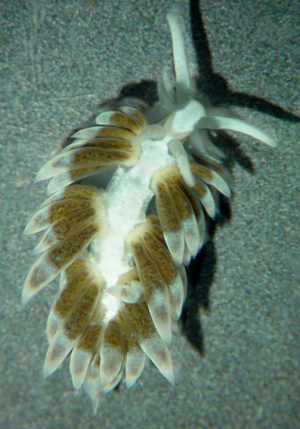Photo of 'Berghia verrucicornis' from Florida
March 22, 2002
From: Stephen C. Kempf

Note added 20 August 2005: This species has been named Aeolidella stephanieae.
Bill,
Here's a fair picture of the animal which we breed here and is used in the aquarium trade to control Aiptasia. We call it Berghia verrucicornis. This is from the Florida Keys. It is a juvenile, about 1/2 - 3/4 inch long, but it looks essentially the same as an adult. The coloration is correct. The brown is due to the zooxanthellae from it's last meal. It maintains these temporarily in the cells lining the digestive diverticula, but will lose them over time if not fed. If these Berghia are reared on bleached Aiptasia, [anemones without zooxanthellae] there is no colored pigment (they appear white to the casual observer). Close inspection reveals a yellow tint to this whiteness with some regions whiter than others. I had to take this shot through my dissecting microscope while the animal was moving, thus the slight fuzziness. I'll try to get a better picture once these animals get larger.
Steve
http://www.auburn.edu/research/hybridoma/
kempfsc@auburn.edu
Kempf, S., 2002 (Mar 22) Photo of 'Berghia verrucicornis' from Florida. [Message in] Sea Slug Forum. Australian Museum, Sydney. Available from http://www.seaslugforum.net/find/6472
Dear Steve,
Thanks very much for this photo. This is the first decent illustration I have seen of the 'USA model' of Berghia verrucicornis and from its external features I would be very surprised if it is the same as the Mediterranean species.
Apart from the obvious colour differences - orange patches in the Mediterranean, white in Florida, there is also the shape of the rhinophores and the cerata. The rhinophores of the Mediterranean animal are reported to have prominent tubercles on the posterior face of the rhinophores merging into ridges along the sides. In your animal there appear to be traces of ridges Are there also tubercles? The cerata of Mediterranean animals are described as spindle-shaped while in your animal the cerata appear to be quite flattened?
I can't be 100% certain from a photo so would be grateful for some information on the shape of the cerata and rhinophores. Apart from the need to compare their anatomy it would also be useful to compare their egg ribbons and developmental biology.
best wishes,
Bill Rudman
Related messages
-
Re: Berghia verrucicornis - aquarium culture [1]
From: Stephen C. Kempf, June 11, 2007 -
Re: 'Berghia verrucicornis' - Captive Life Span
From: Lisa Brown, March 29, 2006 -
New name for Aiptasia-feeding aeolid
From: Bill Rudman, August 20, 2005
